Revell 1/136 P6M Seamaster
|
KIT #: |
0244 |
|
PRICE: |
$12.00 in 1998, or today at hilariously inflated prices online |
|
DECALS: |
The prototype |
|
REVIEWER: |
Ryan Grosswiler |
|
NOTES: |
1996 reissue |
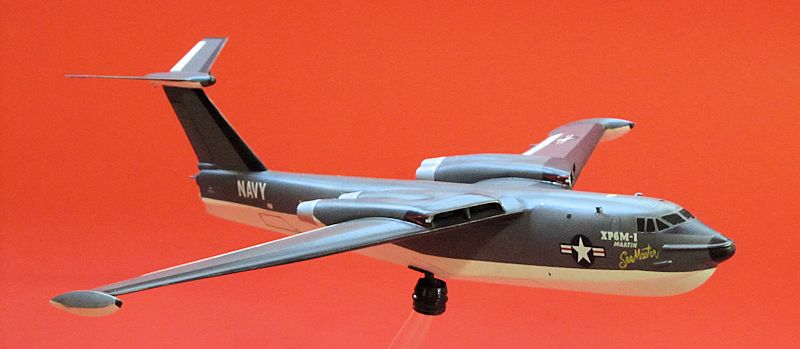
It's well-known that the end of the Second World War brought about atomic
weapons as the global game-changer. What is less well known is how for
a time this got the US Navy's panties all up in a wad.
1942's Battle of the Coral Sea overturned in one stroke the centuries-old
notion of the cannon-armed man-o-war/dreadnought/battleship
deciding the course of affairs for empires: for the very first time in
history naval forces engaged in battle without ever sighting each other.
Instead, their carrier-borne aircraft trading bomb and torpedo decided
everything. So, come the end of the war in 1945, the Navy found itself
pushed uncomfortably to the sidelines by the sudden and very prominent
arrival of air power, particularly when the Army Air Forces was split off
into its own stand-alone USAF. Then along with this came the atom bomb--at
that point an Air Force thing--threatening to relegate the Anchors Aweigh
crowd into a mostly global logistics force to support those actually doing
the fighting. Nuclear bombs could be certainly had by them, but were really
big and heavy at the time and required a specialized means to be carried to
their t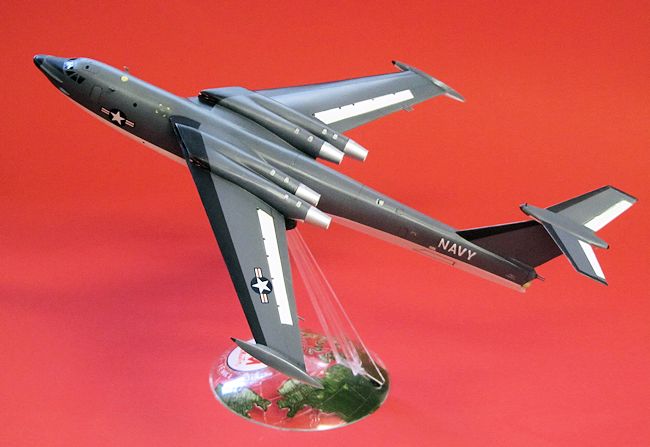 arget.
The Navy was entirely without this means. From this one-two punch, the Navy
scrambled to develop this conveyance and maintain strategic relevance,
launching a variety of technical development programs to do so.
arget.
The Navy was entirely without this means. From this one-two punch, the Navy
scrambled to develop this conveyance and maintain strategic relevance,
launching a variety of technical development programs to do so.
Enter the Martin P6M Seamaster. Though it carried a "P-for-Patrol"
designator, and was being hawked as a minelayer for the above mentioned
political reasons, all involved knew this machine was intended for one thing
and one thing only: fly deep into enemy territory and take out a city or
military installation in a blinding flash. After a brief but fierce battle
with its competitor, Convair, the development contract was finally let to
Martin 1951 and in it, the Navy finally had the answer to the USAF's B-47
and on-the-horizon B-52.
It's not hard to imagine what a technical challenge this must have been:
design a super-fast airplane to fly 1500 miles and drop a 30,000-lb. bomb
load. Oh, and yes: operate it entirely from the open ocean. Anyone who's
ever taken a fall water-skiing or similar while the driver has you in a
tight turn knows that water is by no means 'soft'. Engineering a precision
instrument such as a Mach .90 heavy jet bomber to go bumping along that
rough sea surface on its takeoff run and again on landing is no mean task,
and kudos to the Martin engineers for pulling it off. The wing skins at the
root were fully 1" thick.
Besides the dramatic structural and general performance accomplishments, the
Seamaster incorporated such novel ideas as a pneumatically-sealed, rotating
bomb bay, an all-moving T-tail, wing anhedral that allowed the tip
tanks/floats down close to the water, and a set of air brakes that acted as
water rudders when operated independently. Creative thought was afoot! The
drawback which dogged the concept, of course, is that such a plane would be
dependent on a fleet of specialized support vessels at sea.
Both X-series prototypes crashed in flight testing that began in 1955, but
the subsequent P6M-1 and -2 aircraft gradually incorporated improvements in
a remarkably efficient program--for a radical aircraft--that turned the
design into quite a reliable machine. The jet pods, initially blowing
straight back, were angled outward to prevent scorching the fuselage. As
weight increased, the wings' sharp anhedral was removed, increasing
stability, as the tip floats no longer needed to reach down to the water. A
clear bubble canopy and better engines were introduced in the -2, finally
maturing the aircraft into one ready for the fleet. The first Navy crews
were trained up on the airplane and initial operational capability was just
months away when the program was reduced, slowed, then finally axed in 1959.
Seaplanes by their very nature need to be reliable, durable, and--above
all--logistically independent. As it turned out, the Navy's hyperactive
technological innovation frenzy mentioned above had proven to be the P6M's
own undoing: first, nuclear weapons had been miniaturized so one could sit
comfortably on your coffee table, and a series of progressively-better land
planes had been developed in the form of the mixed-propulsion AJ Savage,
then the all-jet AD Skywarrior, and finally the supersonic A-5
Vigilante--nuclear bombers that could ride along on an ordinary aircraft
carrier. But even these would be shortly trumped by
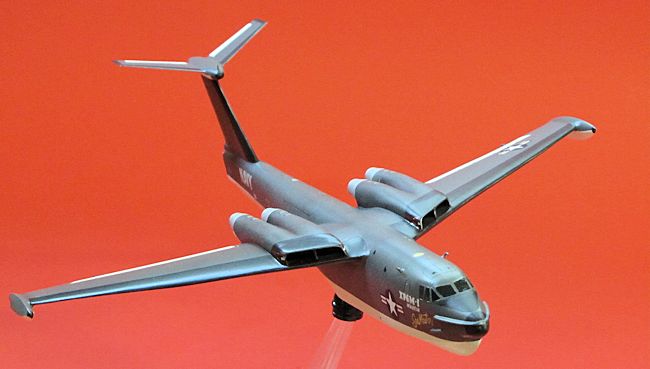 that
ultimate boogeyman for the atomic age: The Polaris missile married to the
nuclear sub. No longer would the fleet require multiple ships to support a
single plane to drop a single bomb. One ship could deliver many bombs. In
this turf war with the Air Force, the Navy indeed had the last Strangelovian
laugh: the power to absolutely obliterate an entire nation with many
warheads had become concentrated in a single vessel, operating by itself and
untrackable, worldwide, constantly. The Navy had a whole fleet of them!
that
ultimate boogeyman for the atomic age: The Polaris missile married to the
nuclear sub. No longer would the fleet require multiple ships to support a
single plane to drop a single bomb. One ship could deliver many bombs. In
this turf war with the Air Force, the Navy indeed had the last Strangelovian
laugh: the power to absolutely obliterate an entire nation with many
warheads had become concentrated in a single vessel, operating by itself and
untrackable, worldwide, constantly. The Navy had a whole fleet of them!
The 14 production and now mission-less Seamasters had all been parked and
scrapped within a year or two, with only a few bits surviving in museum
storage today. This event was Strike Three for the pioneering Glenn L.
Martin Company's attempts to succeed in the postwar world. This followed the
failure of the XB-48 and XB-51 (and being awarded license production of the
British Canberra bomber as a booby prize) and thereafter the company
declared itself an electronics and missiles maker.
Still, the Seamaster was marvelous piece of engineering, the very pinnacle
of marine aircraft design, and it's difficult to imagine such a project
being attempted in today's If-It-Hasn't-Been-Done-Before-It-Can't-Be-Done
aerospace industry. It's also fascinating to think of what might have
happened had the design been cleaned up and the basic formula developed into
a land plane: those seaborne durability requirements would have translated
very well into an airframe optimized for low-altitude strike, and right at
the very time both the USAF and USN were abandoning high altitudes for
bombing, in an F-111-like role. The USAF might not have lost those 17 B-52s
in combat over North Vietnam, though it was lazy tactics, not aircraft
performance, which caused this over a few December nights. But now I'm
getting into the weeds here.
I've always had a soft spot in my heart for seaplanes, as all have that air
about them which screams, "adventure!". This one's my favorite, what with
that rakish tail, pointy lines, and hulking engine
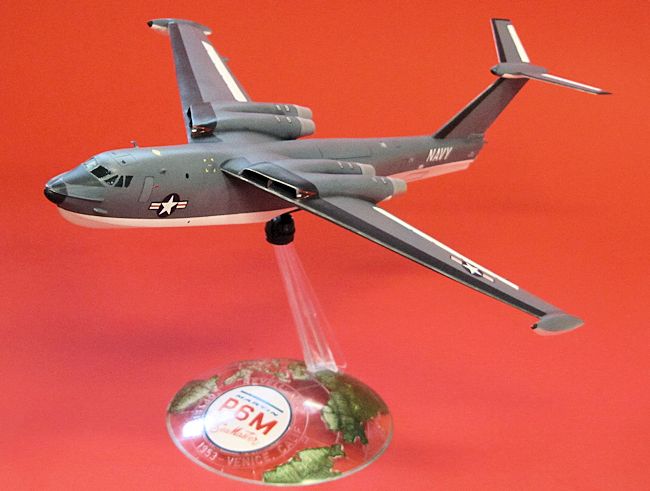 pods
bulging like overdeveloped quadriceps. Revell's odd fit-the-box scale of
1/136 is just the ticket for those not wanting to attempt the shelf-hogging
1/72 vac-formAirmodel, resin Anigrand, or short-run plastic Mach
2 offerings: this completed model is just under a foot long. Revell cut the
molds for this while the real thing was making industry headlines, and it
bears all the marks of a 1950s plastic kit: boiler-plate rivets, decal
locations conveniently raised on the surface for you, no landing gear, an
odd scale. Seventeen--yes, 17-- dark-blue parts greet you upon opening the
box, broken down in predictable fashion. The early issues (and mine) had the
articulated "Revelving" stand for this landing-gear-less aircraft, other
issues had a simple pebbled-texture plinth to stick the model on to. As
molded and decaled, it depicts the two 'X' prototypes with the anhedral,
'straight' engine nacelles, and early cockpit windows.
pods
bulging like overdeveloped quadriceps. Revell's odd fit-the-box scale of
1/136 is just the ticket for those not wanting to attempt the shelf-hogging
1/72 vac-formAirmodel, resin Anigrand, or short-run plastic Mach
2 offerings: this completed model is just under a foot long. Revell cut the
molds for this while the real thing was making industry headlines, and it
bears all the marks of a 1950s plastic kit: boiler-plate rivets, decal
locations conveniently raised on the surface for you, no landing gear, an
odd scale. Seventeen--yes, 17-- dark-blue parts greet you upon opening the
box, broken down in predictable fashion. The early issues (and mine) had the
articulated "Revelving" stand for this landing-gear-less aircraft, other
issues had a simple pebbled-texture plinth to stick the model on to. As
molded and decaled, it depicts the two 'X' prototypes with the anhedral,
'straight' engine nacelles, and early cockpit windows.
Pretty straightforward, mostly an average exercise in
fit-glue-putty-sand-primer-repeat. Especially that
crude wing-to-fuselage joint made completely diabolical by the proximity of
those engine nacelles. Several rounds of the above mantra solved this. That,
and a made-for-the-task pointed sanding tool. The engine intake lips took a
few rounds of this as well. The stabilizer fairing has an odd, flattened
cross section, so this was bulked out up above with some epoxy putty and
sanded to a more rounded contour. The entire airframe was then given an
overall sanding to get rid of the inaccurate boiler-plate detailing and a
smooth surface.
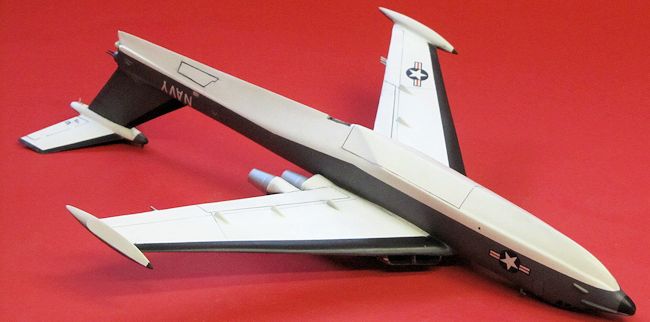 The
main challenge lies with the cockpit windows: The single clear part bears
little resemblance to the real thing, so was glued, filled in, and sanded
flush like any other airframe part. However, I absolutely hate opaque
windows on models (I consider it a modeling cop-out, along with intake
covers, which reduces the finished product's interest). But when I caught
myself contemplating vac-forming the entire cockpit area or even cutting out
the individual window panes, inner reason hollered, "Whoa, dude, get a
grip!"
The
main challenge lies with the cockpit windows: The single clear part bears
little resemblance to the real thing, so was glued, filled in, and sanded
flush like any other airframe part. However, I absolutely hate opaque
windows on models (I consider it a modeling cop-out, along with intake
covers, which reduces the finished product's interest). But when I caught
myself contemplating vac-forming the entire cockpit area or even cutting out
the individual window panes, inner reason hollered, "Whoa, dude, get a
grip!"
The cue to resolving this pickle came from Kalmbach's excellent Famous
Spaceships: both Fact and Fantasy...and how to model them (given to me by my
grandparents for Christmas 1981, starting me on the dubious road to 'serious
modelling'. Still being referenced over 30 years later!) and the treatment
of the Revell 1/144th Space Shuttle's windows within its pages. First, I
carefully filed the cockpit window areas flat to achieve the prominent
'faceting' of each pane. Second, I even more carefully scribed the window
panes themselves, using a small straightedge and the kit clear part outline
as a level guide. Third, the 'panes' were painted Xtracolor USN Gloss Sea
Blue. Finally came the defining steps: the panes were masked with Tamiya
tape, then followed by several sessions of black primer, gently sanding to
reveal the
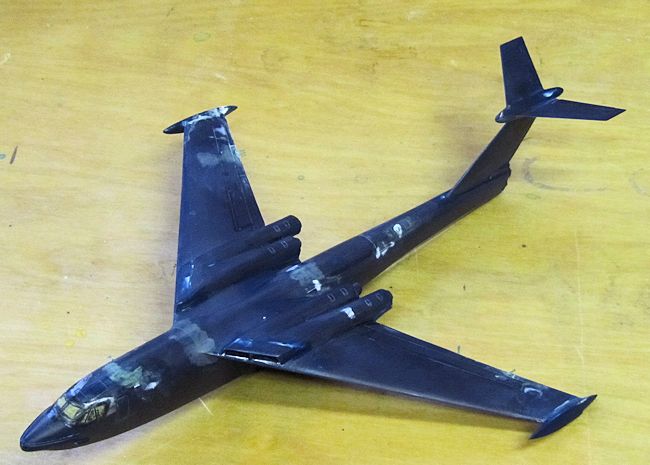 masking
tape, and repeat. This visibly built up 'window frames', and the dark blue
paint gave off a subtly pleasing contrast of hue against the overall grey
airframe color (see below) which came later. In this manner, the faceting,
contrasting hue, gloss sheen, and well-defined window frames combined to
make the opaque windows appear as a distinct, built-in airframe feature and
not something sprayed on the surface as an afterthought.
masking
tape, and repeat. This visibly built up 'window frames', and the dark blue
paint gave off a subtly pleasing contrast of hue against the overall grey
airframe color (see below) which came later. In this manner, the faceting,
contrasting hue, gloss sheen, and well-defined window frames combined to
make the opaque windows appear as a distinct, built-in airframe feature and
not something sprayed on the surface as an afterthought.
In these small scales, most surface detail should otherwise not be present,
so I studied photos to see what was clearly visible in real life average
viewing distances. A few prominent panels were then scribed, namely the
spoilers, air brakes/water rudders, bomb bay door, loading door, ejection
hatches, and little APU ports and engine accessories up top. Fuel-jettison
(I think) pipes were created from Albion Alloys brass tubes and faired into
the trailing edge, and the pitot and trim probes cut and shaped from
aluminum sheet and extending into the plastic for strength. In this scale,
most surface detail should disappear and depicting every little surface line
and widget just makes the model look 'draggy'. I dislike the inane artists'
quip, 'Less is more', but sometimes less is more effective. She was ready
for the paint shop.
The first prototype was boring Gloss Sea Blue, so I chose the far more
interesting grey-over-anti-flash-white (another clue to the real mission of
this plane) scheme of second X-bird, all sprayed using Testor's
square-bottle enamels. This scheme also got me out of depicting the
ginormous square-section pitot tube sported by the first aircraft. A coat of
Future (now under the Pledge brand name) prepped it for decals. The
stars-and-bars provided with the kit had bars too skinny, and the NAVY
titles were the wrong font, so
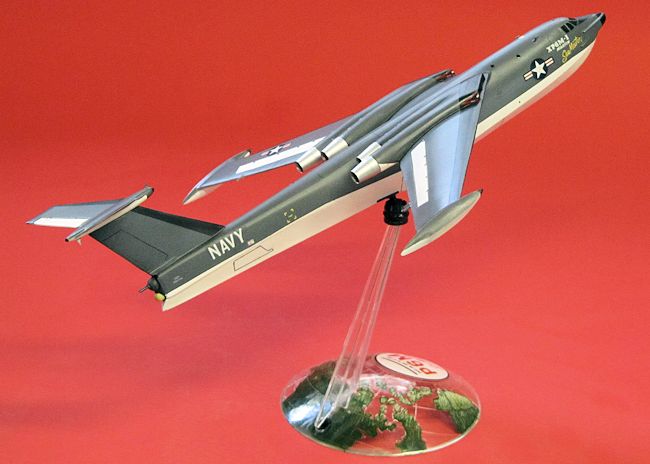 markings
mostly were cobbled up from odds and ends in the spares box. I did salvage
the "XP6M-1" and "Seamaster" images. These went on and cured nicely, but the
red 'Seamaster' bit nearly disappeared against the dark airframe color. I
therefore had to hand-paint it with a 000 brush and a lot of patience. I
didn't apply it to the left side, partly to avoid repeating this effort and
also to give the model a more 'operational' look. A few more panel lines
were then drawn in lightly with a mechanical pencil, again referencing
period photos. Stencil markings were dabbled on with the same brush in a
notional sort of way, and a few squirts of Testor's Semi-gloss, decanted
into my airbrush, sealed the whole business up.
markings
mostly were cobbled up from odds and ends in the spares box. I did salvage
the "XP6M-1" and "Seamaster" images. These went on and cured nicely, but the
red 'Seamaster' bit nearly disappeared against the dark airframe color. I
therefore had to hand-paint it with a 000 brush and a lot of patience. I
didn't apply it to the left side, partly to avoid repeating this effort and
also to give the model a more 'operational' look. A few more panel lines
were then drawn in lightly with a mechanical pencil, again referencing
period photos. Stencil markings were dabbled on with the same brush in a
notional sort of way, and a few squirts of Testor's Semi-gloss, decanted
into my airbrush, sealed the whole business up.
Try as I might, I could not find a single photograph depicting on the real
plane the neat Crown-and-Trident markings provided by Revell, though I
sorely wanted to dress the tail up with them. I was also tempted to do a
hypothetical operational finish with unit markings. Ideas for you.
Finally, that "Revelving" stand was made up. It took a few licks of paint
applied inside the ball-and-socket joint to get the friction required for
the model to hold any flight attitude except straight up or straight down. I
went artsy with the Northern Hemisphere image molded underneath in the base,
painting the landmasses green, then scratching through the paint over arctic
areas in lines of longitude, following this with white which showed through,
nicely 'frosting' the arctic regions. I then applied the big, round "Martin
P6M Seamaster" decal. This last required six radial slits cut almost all the
way to the center followed by a good dousing of decal softener to conform to
the curve, but looks good when dry.
The box, reprinted from its original 1950s issue, proudly declares, "Scaled
From Official Prints". It sure looks to be that way, as the finished model
captures the contours and proportions of the real thing absolutely bang-on
from every angle. But this project consumed time waaaaay out of proportion
to its size
 and
simplified detail. I made no attempt to make it a contest-worthy model,
knowing that my coworkers would pick it up and play with it (aviators, both
civil and military, are not known for their social maturity) but I still
poured about 25 hours into it. As an inspirational object, however, it
totally delivers. I'm very happy with this one now that it's done. That
rakish shape looks great on my desk, and coworkers (while picking it up and
playing with it) peppered me with all sorts of questions as to what it was.
None of them had ever heard of the thing--a reminder of the esoteric
pursuits we modellers wallow in.
and
simplified detail. I made no attempt to make it a contest-worthy model,
knowing that my coworkers would pick it up and play with it (aviators, both
civil and military, are not known for their social maturity) but I still
poured about 25 hours into it. As an inspirational object, however, it
totally delivers. I'm very happy with this one now that it's done. That
rakish shape looks great on my desk, and coworkers (while picking it up and
playing with it) peppered me with all sorts of questions as to what it was.
None of them had ever heard of the thing--a reminder of the esoteric
pursuits we modellers wallow in.
Get an issue with the tall stand or cobble one up: this model looks much
better perched gloriously up on high than squatting on that stupid plinth.
Note that the odd scale isn't too far off for a 1/144th scale collection,
if you don't mind the +/- 6% difference.
Breihan, John. Martin Aircraft, 1909-1960. Narkiewicz/Thompson, 1995
Smith, Bob. PBM Mariner in action. Squadron-Signal, 1986 (includes 6 pages
covering the P6M)
The Internet
Note: I don't own a copy, but Stan Piet and Al Riethel's Martin P6M
Seamaster (ISBN# 978-0970066206) is apparently the
ultimate reference for this type: at 224 pages and in a landscape format
undoubtedly packed with photos, it will be an essential tool if you attempt
this subject in 1/72!
Ryan Grosswiler
May 2015
Copyright ModelingMadness.com. All rights reserved. No
reproduction in part or in whole without express permission from the editor.
If you would like your product reviewed fairly and fairly
quickly, please
contact
the editor
or see other details in the
Note to
Contributors.
Back to the Main Page
Back to the Review Index Page


 arget.
The Navy was entirely without this means. From this one-two punch, the Navy
scrambled to develop this conveyance and maintain strategic relevance,
launching a variety of technical development programs to do so.
arget.
The Navy was entirely without this means. From this one-two punch, the Navy
scrambled to develop this conveyance and maintain strategic relevance,
launching a variety of technical development programs to do so. that
ultimate boogeyman for the atomic age: The Polaris missile married to the
nuclear sub. No longer would the fleet require multiple ships to support a
single plane to drop a single bomb. One ship could deliver many bombs. In
this turf war with the Air Force, the Navy indeed had the last Strangelovian
laugh: the power to absolutely obliterate an entire nation with many
warheads had become concentrated in a single vessel, operating by itself and
untrackable, worldwide, constantly. The Navy had a whole fleet of them!
that
ultimate boogeyman for the atomic age: The Polaris missile married to the
nuclear sub. No longer would the fleet require multiple ships to support a
single plane to drop a single bomb. One ship could deliver many bombs. In
this turf war with the Air Force, the Navy indeed had the last Strangelovian
laugh: the power to absolutely obliterate an entire nation with many
warheads had become concentrated in a single vessel, operating by itself and
untrackable, worldwide, constantly. The Navy had a whole fleet of them!  pods
bulging like overdeveloped quadriceps. Revell's odd fit-the-box scale of
1/136 is just the ticket for those not wanting to attempt the shelf-hogging
1/72 vac-formAirmodel, resin Anigrand, or short-run plastic Mach
2 offerings: this completed model is just under a foot long. Revell cut the
molds for this while the real thing was making industry headlines, and it
bears all the marks of a 1950s plastic kit: boiler-plate rivets, decal
locations conveniently raised on the surface for you, no landing gear, an
odd scale. Seventeen--yes, 17-- dark-blue parts greet you upon opening the
box, broken down in predictable fashion. The early issues (and mine) had the
articulated "Revelving" stand for this landing-gear-less aircraft, other
issues had a simple pebbled-texture plinth to stick the model on to. As
molded and decaled, it depicts the two 'X' prototypes with the anhedral,
'straight' engine nacelles, and early cockpit windows.
pods
bulging like overdeveloped quadriceps. Revell's odd fit-the-box scale of
1/136 is just the ticket for those not wanting to attempt the shelf-hogging
1/72 vac-formAirmodel, resin Anigrand, or short-run plastic Mach
2 offerings: this completed model is just under a foot long. Revell cut the
molds for this while the real thing was making industry headlines, and it
bears all the marks of a 1950s plastic kit: boiler-plate rivets, decal
locations conveniently raised on the surface for you, no landing gear, an
odd scale. Seventeen--yes, 17-- dark-blue parts greet you upon opening the
box, broken down in predictable fashion. The early issues (and mine) had the
articulated "Revelving" stand for this landing-gear-less aircraft, other
issues had a simple pebbled-texture plinth to stick the model on to. As
molded and decaled, it depicts the two 'X' prototypes with the anhedral,
'straight' engine nacelles, and early cockpit windows.  The
main challenge lies with the cockpit windows: The single clear part bears
little resemblance to the real thing, so was glued, filled in, and sanded
flush like any other airframe part. However, I absolutely hate opaque
windows on models (I consider it a modeling cop-out, along with intake
covers, which reduces the finished product's interest). But when I caught
myself contemplating vac-forming the entire cockpit area or even cutting out
the individual window panes, inner reason hollered, "Whoa, dude, get a
grip!"
The
main challenge lies with the cockpit windows: The single clear part bears
little resemblance to the real thing, so was glued, filled in, and sanded
flush like any other airframe part. However, I absolutely hate opaque
windows on models (I consider it a modeling cop-out, along with intake
covers, which reduces the finished product's interest). But when I caught
myself contemplating vac-forming the entire cockpit area or even cutting out
the individual window panes, inner reason hollered, "Whoa, dude, get a
grip!" masking
tape, and repeat. This visibly built up 'window frames', and the dark blue
paint gave off a subtly pleasing contrast of hue against the overall grey
airframe color (see below) which came later. In this manner, the faceting,
contrasting hue, gloss sheen, and well-defined window frames combined to
make the opaque windows appear as a distinct, built-in airframe feature and
not something sprayed on the surface as an afterthought.
masking
tape, and repeat. This visibly built up 'window frames', and the dark blue
paint gave off a subtly pleasing contrast of hue against the overall grey
airframe color (see below) which came later. In this manner, the faceting,
contrasting hue, gloss sheen, and well-defined window frames combined to
make the opaque windows appear as a distinct, built-in airframe feature and
not something sprayed on the surface as an afterthought. markings
mostly were cobbled up from odds and ends in the spares box. I did salvage
the "XP6M-1" and "Seamaster" images. These went on and cured nicely, but the
red 'Seamaster' bit nearly disappeared against the dark airframe color. I
therefore had to hand-paint it with a 000 brush and a lot of patience. I
didn't apply it to the left side, partly to avoid repeating this effort and
also to give the model a more 'operational' look. A few more panel lines
were then drawn in lightly with a mechanical pencil, again referencing
period photos. Stencil markings were dabbled on with the same brush in a
notional sort of way, and a few squirts of Testor's Semi-gloss, decanted
into my airbrush, sealed the whole business up.
markings
mostly were cobbled up from odds and ends in the spares box. I did salvage
the "XP6M-1" and "Seamaster" images. These went on and cured nicely, but the
red 'Seamaster' bit nearly disappeared against the dark airframe color. I
therefore had to hand-paint it with a 000 brush and a lot of patience. I
didn't apply it to the left side, partly to avoid repeating this effort and
also to give the model a more 'operational' look. A few more panel lines
were then drawn in lightly with a mechanical pencil, again referencing
period photos. Stencil markings were dabbled on with the same brush in a
notional sort of way, and a few squirts of Testor's Semi-gloss, decanted
into my airbrush, sealed the whole business up. and
simplified detail. I made no attempt to make it a contest-worthy model,
knowing that my coworkers would pick it up and play with it (aviators, both
civil and military, are not known for their social maturity) but I still
poured about 25 hours into it. As an inspirational object, however, it
totally delivers. I'm very happy with this one now that it's done. That
rakish shape looks great on my desk, and coworkers (while picking it up and
playing with it) peppered me with all sorts of questions as to what it was.
None of them had ever heard of the thing--a reminder of the esoteric
pursuits we modellers wallow in.
and
simplified detail. I made no attempt to make it a contest-worthy model,
knowing that my coworkers would pick it up and play with it (aviators, both
civil and military, are not known for their social maturity) but I still
poured about 25 hours into it. As an inspirational object, however, it
totally delivers. I'm very happy with this one now that it's done. That
rakish shape looks great on my desk, and coworkers (while picking it up and
playing with it) peppered me with all sorts of questions as to what it was.
None of them had ever heard of the thing--a reminder of the esoteric
pursuits we modellers wallow in.